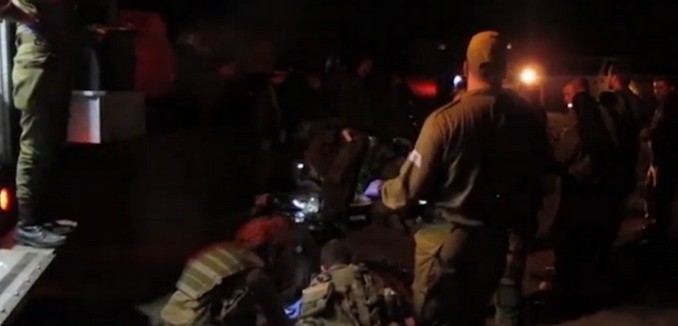Eight seriously injured Syrians, including children aged seven and 11, were treated by IDF medical teams at the Israeli-Syrian border last week before being evacuated to hospitals for further treatment, Ynet reported Sunday.
The wounded were brought to the border fence following an artillery attack on the hospital in Quneitra, reportedly carried out by forces of Syrian dictator Bashar al-Assad.
The wounded suffered from injuries to all parts of their bodies as well as burns. Dozens of IDF medical personnel worked under the cover of darkness to stabilize them.
“We were forced to call in medical teams from the armored corps who happened to be doing drills that day in the Golan to supplement the medical forces of the brigade which is normally responsible for the area, alongside various reserve forces,” explained medic Micky Almakis.
Seven medical teams, including high ranking medical personnel were called to the area. The two children had burns all over their bodies and were in real danger of losing their lives. They were groaning from the pain they were in. Now, they’re recovering and being taken care of by the best people. Their grandmother came to accompany them, and thanked us for treating them. The wounded Syrians were surprised at the care and compassion we gave to them when they crossed the border over to us.
The medical team was forced to perform emergency procedures, including opening blocked airways and draining fluid from chests, immediately upon the Syrians’ arrival in Israel.
“The kids looked terrible,” recounted IDF paramedic Michel Pushkov. “We gave them medicine, and despite the fact that they were terrified, they answered our questions. The moment they understood that I was there to help them, they looked a lot happier. They were administered fluids and sterile blankets to prevent against infection and hypothermia.”
The fighting in the area has been fueled by a push by Assad’s forces to capture territory on the border with Israel.
There have been 2,500 Syrians treated in Israeli hospitals since Israel began accepting casualties from the war three years ago.
Aside from the humanitarian aspect to saving those wounded in the war, cooperation with rebel groups near Israel’s border also affords Israel a measure of protection, as Jonathan Spyer described in How Israel Navigated Through the Hurricane of the Syrian Civil War, which was published in the March 2016 issue of The Tower Magazine.
It is an open secret in Israel that the country maintains relations with Sunni rebel elements in the area adjoining the border in Quneitra Province. The reason is to ensure that they remain the dominant force on the border, rather than elements aligned with the Assad regime, Iran, or the Lebanese terror group Hezbollah. The Israeli policy of providing medical aid to Syrian civilians and wounded rebel fighters from this area is clearly an aspect of this policy (in addition to purely humanitarian considerations). The precise nature of the assistance afforded the rebels is not known. No evidence, however, has emerged of direct military aid. Given the great efforts to which Israel goes in order to ensure a clear intelligence “picture” of events in southwest Syria, it may be assumed that intelligence sharing probably forms part of the relationship.
The rebels located close to the border are a mixed bunch. In the southern corner is Liwa Shuhada al-Yarmouk, a rebel group of long standing which is now clearly affiliated with the Islamic State. Israel has closely followed the movement of this organization in the direction of IS and is concerned about it. The relations between Israel and the group are hostile, though they have not yet resulted in open violence. There are Israeli concerns that a second rebel group in the area, the Harakat al-Muthanna al-Islamiya organization, may also be moving closer to the Islamic State.
According to informed sources, Israeli contacts with rebel elements close to the border are not limited to the Western-supported rebel coalition called the Southern Front. They also include elements sympathetic to and affiliated with Sunni Islamist groups. Israeli sources note that the rebellion is a fragmented, localized phenomenon. As such, it has been possible to foster small-scale cooperation independent of the broader ideological sympathies of these groups. As a result, one former senior security official described the area east of Quneitra Crossing as a “virtual security zone” for Israel.
[Photo: Ynet ]




